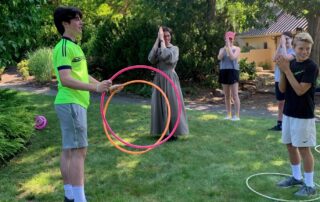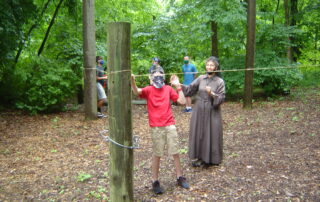 Pillar: Relationship
Pillar: Relationship
Laudato Si’ Action Plan Goals: Community Engagement and Participatory Action
 Pillar: Relationship
Pillar: Relationship
Laudato Si’ Action Plan Goals: Community Engagement and Participatory Action
Group (Grade Levels): Older children through adults
Learning Goals:
- Practice communication (both listening and speaking), focus, and trust in others
- Build self-confidence that manifests in smooth teamwork
- Meet concrete goal as a group while learning skills to meet intangible goals
Materials Needed: Blindfolds; a variety of objects about the size of a chalkboard eraser. These should be sturdy and will be placed on the ground with the potential to be stepped on. Good options could include small foam footballs, empty water bottles, or toys.
Estimated Time to Complete Activity: About 1 hour and 15 minutes: 15-20 minutes for opening discussion; 15 to 30 minutes for activity; up to 20 minutes to debrief.
Pre-planning: Gather blindfolds and objects to hide. Find an open, relatively flat location where the group can spread out, such as a gym, field, or blacktop. Optional: create groups of three ahead of time in order to facilitate appropriate behavior.
General Outline of Experience
- Prayerfully read the Scripture passage in Mt 4:18-22: Jesus calls Peter and Andrew to be Fishers of Men. Follow with the Lord’s prayer, lead a spontaneous prayer or go directly into discussion with questions below.
- As he was walking by the Sea of Galilee, he saw two brothers, Simon who is called Peter, and his brother Andrew, casting a net into the sea; they were fishermen. He said to them, “Come after me, and I will make you fishers of men.” At once they left their nets and followed him. He walked along from there and saw two other brothers, James, the son of Zebedee, and his brother John. They were in a boat, with their father Zebedee, mending their nets. He called them, and immediately they left their boat and their father and followed him (Mt 4:18-22).
- Lead group in discussion about God calling each person to follow him and develop our unique gifts, not alone, but together.
- Laudato Si’ Quotes
- “Human beings, while capable of the worst, are also capable of rising above themselves, choosing again what is good, and making a new start, despite their mental and social conditioning. We are able to take an honest look at ourselves, to acknowledge our deep dissatisfaction, and to embark on new paths to authentic freedom. … I appeal to everyone throughout the world not to forget this dignity which is ours” (Laudato Si’, n. 205).
- What are you capable of, as an individual?
- What are we capable of, as a group?
- “We are always capable of going out of ourselves towards the other. Unless we do this, other creatures will not be recognized for their true worth; we are unconcerned about caring for things for the sake of others… If we can overcome individualism, we will truly be able to develop a different lifestyle and bring about significant changes in society” (Laudato Si’, n. 208).
- Why is it important to go out of ourselves towards the other?
- What does it look like when we do this at our [school, parish, in our group]?
- “Human beings, while capable of the worst, are also capable of rising above themselves, choosing again what is good, and making a new start, despite their mental and social conditioning. We are able to take an honest look at ourselves, to acknowledge our deep dissatisfaction, and to embark on new paths to authentic freedom. … I appeal to everyone throughout the world not to forget this dignity which is ours” (Laudato Si’, n. 205).
- “We are always capable of going out of ourselves towards the other. Unless we do this, other creatures will not be recognized for their true worth; we are unconcerned about caring for things for the sake of others… If we can overcome individualism, we will truly be able to develop a different lifestyle and bring about significant changes in society” (Laudato Si’, n. 208).
- Why is it important to go out of ourselves towards the other?
- What does it look like when we do this at our [school, parish, in our group]?
Concrete opening experience:
Give all students except one (“the Listener”) a different sentence to say. Speakers should begin repeating their sentences over and over. Tell the Listener which sentence he/she should try to identify. The Listener may walk around the room to find the person who is saying that sentence while all speakers continue to repeat their sentences.
Lead up to key point: Listening takes focus.
Transition to activity: Explain that in the cooperative activity we are about to do, we will need to focus, listen for the voice of a specific person, and communicate to achieve a goal.
Orientation to tools/elemental techniques: Blindfold, voices, object you are searching for, safe movement with a blindfold on
Demonstration of how to use tools
- Show how to tie a blindfold.
- Demonstrate how to direct a blindfolded person by specific verbal directions (i.e., “Take a small step forward,” not just “Walk.”)
- Students will be in groups of 3.
- First, the coordinator introduces the following story: Once upon a time there was a king who had N children (N – referring to the number of teams). Then a frightful dragon came and took away the king’s children and put them in his distant tower. The task of each team is to find their prince/princess and get him/her back home.
- Each team consists of the following three players: the Silent One (who is allowed to look, but isn’t allowed to talk), the Talker (who is only allowed to look at the Silent One’s pantomime, and is allowed to talk), and the Tracker (who is blindfolded and navigated by the Talker in his quest to find the prince/princess).
- The Coordinator picks objects to represent the princes/princesses and assigns one to each team. He then places the object representing the prince/princess some distance away across the area being used. Only the Silent Ones from each team are allowed to see where the coordinator has placed their group’s prince/princess. Talker and Tracker mustn’t see this.
- All team members stand on one side of the area. The Silent One has an overview of the whole area. When the game begins, he uses pantomime to explain to the Talker, who is facing him, where their prince/princess is located some distance away. The Talker only sees the Silent One and his pantomime and tries to verbally navigate the Tracker, using the information he receives from the Silent One. The blindfolded Tracker then moves while the other two stay, and with help of his teammates, tries to find their prince/princess and to get him/her back to his teammates successfully.
- The winner is the team whose Tracker finds their prince/princess and gets her back first. It is crucial that teammates play their roles well and cooperate in order to successfully finish the task. This is a hilarious game with a great atmosphere!
- Ideas for follow-up in future sessions:
- Variations of this activity include trying it with obstacles such as trees or gym equipment, requiring a lower voice volume (regular speaking tone; whisper), having one group perform the task while others attempt to distract, having the person who finds the object continue to travel with it, moving it to a pre-determined location, etc.
- Other activities that could build on these skills include “Pitfalls” or trust walks.
Ask the group what positive traits they observed in one another as they completed the activity. List these on a poster to remind and discuss.
Proposed discussion questions:
- What went well? What strategies worked?
- What did not work?
- Did your group change tactics as you went? If so, how, and was it effective?
- How did it feel to be the blindfolded person? The silent person? The person giving directions?
- What helped your communication?
- Where did you experience focus? Trust? Communication? (Other skills you would like to highlight for your group?)
Potential analogies:
Can you think of a time when….
- You felt “in the dark”?
- You had to counsel someone who didn’t know what to do?
- You had to go do something on your own? Who supported you as you did the task?
- You were part of a group that worked well together? What about a group that didn’t work well together?
- If time, discuss the following story from the life of St. Francis, which demonstrates his profound relationality.
Another time when blessed Francis was at that same place, a certain spiritual brother, an elder in religion, was there. He was very sick and weak. Considering him, blessed Francis was moved to piety toward him. The brothers back then, sick and healthy, with great cheerfulness took poverty for abundance. They did not use nor ask for medicines in their illnesses, but rather willingly chose what was contrary to the body. Blessed Francis said to himself: “If that brother would eat some ripe grapes early in the morning, I believe it would help him.” And he did what he had been thinking. One day he secretly got up early in the morning and called that brother and took him into the vineyard which was close by the place. He chose one vine with good grapes to eat. Sitting down with that brother next to the vine, he began to eat some grapes so that the brother would not be ashamed to eat alone, and while they were eating them, that brother was cured and together they praised the Lord God. As long as he lived, he very often recalled among the brothers, with great devotion and flowing tears, the mercy and piety the holy father had shown to him. (https://franciscantradition.org/francis-of-assisi-early-documents/the-prophet/a-mirror-of-the-perfection-1318/a-mirror-of-the-perfection-the-sabatier-edition-1928/2181-fa-ed-3-page-280.)
Cross-references to related experiential activities:
If this is part of a sequence of community-building exercises, you can refer back to a previous experience and skills gained there.




